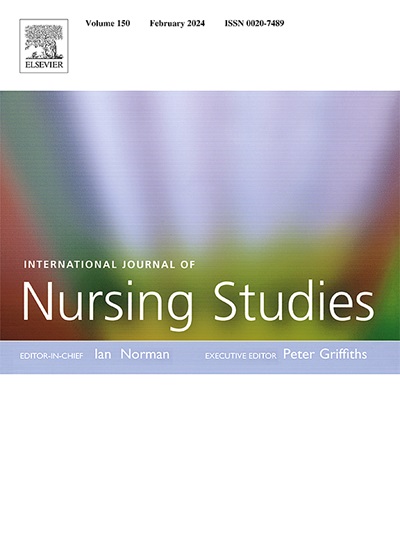住院儿童和青少年的体征和症状引发护士的关注--一项横跨丹麦和挪威的定性研究。
IF 7.5
1区 医学
Q1 NURSING
引用次数: 0
摘要
背景:由于儿童的年龄差异,如生命体征和影响儿童的广泛医疗条件,对住院儿童的体征和症状进行评估是一项独特的挑战。及早发现儿童的临床变化对防止病情恶化至关重要,虽然有标准化的工具,但人们越来越认识到需要根据经验丰富的护士的知识和直觉来考虑主观因素:探讨除生命体征外,哪些体征和症状会引发护士对住院儿童和青少年病情恶化的关注:本研究采用描述性定性设计:研究在丹麦的三个儿科部门和挪威一所大学的护理系进行,这所大学为在挪威各地从事儿童和青少年工作的医疗保健专业人员提供研究生教育课程:方法:采用四次焦点小组访谈的方式,收集了有关儿童和青少年健康问题的信息:方法:通过四次焦点小组访谈收集数据,并采用归纳内容分析法进行分析:结果:护士对儿童临床状况的了解受到护士经验、感官使用(如用手触摸儿童)以及各种方法使用的影响。来自家长的有关儿童正常行为的信息被认为是有价值的。这些信息来源通常难以用语言表达,可以被称为直觉或 "直觉",当生命体征显示正常时,这些信息往往会指导护士的行动,护士依靠感官来评估患儿的病情。引发关注的具体指标包括呼吸、循环、意识水平和面部表情的变化。夜间评估、与家长的互动、电子设备的存在以及儿童的补偿能力都会带来挑战。临床经验是护士识别儿童病情变化能力的重要因素:本研究强调了护士对住院儿童临床状况评估的多面性。护士利用自己的经验、直觉以及与家长的互动来补充基于生命体征的评估。当生命体征不能完全反映患儿的临床状况时,护士的直觉或 "直觉 "就会成为一种宝贵的工具。引发护士关注的具体体征和症状,以及他们所面临的挑战,有助于全面了解评估儿童临床状况的复杂性。这些研究结果强调了护士在早期识别住院儿童临床病情恶化方面的作用,以及除生命体征外进行评估的必要性。本文章由计算机程序翻译,如有差异,请以英文原文为准。
Signs and symptoms in hospitalized children and adolescents' triggering nurses' awareness – A qualitative study across Denmark and Norway
Background
Assessment of signs and symptoms in hospitalized children presents unique challenges due to the children's age-related differences, such as vital signs and the broad range of medical conditions that affects children. Early detection of clinical changes in children is crucial to prevent deterioration, and while standardized tools exist, there is a growing recognition of the need to consider subjective factors based on experienced nurses' knowledge and intuition.
Objective
To explore which signs and symptoms, apart from vital signs, that trigger nurses' concern regarding deterioration of hospitalized children and adolescents.
Design
This study used a descriptive qualitative design.
Settings
The study was conducted at three pediatric departments in Denmark and a nursing department of a university in Norway, offering post graduate education programs for health care professions working with children and adolescents throughout Norway.
Participants
A total sample of 29 registered nurses with varying levels of experience participated.
Method
Four focus group interviews were used to collect data and analyzed with inductive content analysis approach.
Results
Nurses' knowledge about children's clinical conditions is influenced by the nurses experience, their use of senses like touching the child with their hands, and the use of various approaches. Information from parents about the child's normal behavior are considered valuable. These sources of information, often difficult to verbalize, might be referred to as intuition or “gut feeling” and often guides the nurses' actions when vital signs appear normal, and nurses rely on their senses to assess the child's condition. Specific indicators triggering concern include changes in respiration, circulation, level of consciousness, and facial expressions. Challenges arise from nighttime assessments, interactions with parents, the presence of electronic devices, and children's ability to compensate. Clinical experience is a significant factor in nurses' ability to recognize changes in in the child's condition.
Conclusion
This study highlights the multifaceted nature of nurses' assessments of clinical conditions in hospitalized children. Nurses draw on their experiences, intuition, and interactions with parents to complement vital signs-based assessments. Their intuition, or “gut feeling” serves as a valuable tool when vital signs do not fully capture the child's clinical status. Specific signs and symptoms that trigger nurses' concern, along with the challenges they face, contribute to a comprehensive understanding of the complexity of assessing children's clinical conditions. These findings, emphasize the role of nurses in early recognition of clinical deterioration in hospitalized children and the need for assessments that go beyond vital signs.
Tweetable abstract
Both objective assessments and intuitive clinical judgment play an important role in identifying potential deterioration in pediatric patients.
求助全文
通过发布文献求助,成功后即可免费获取论文全文。
去求助
来源期刊
CiteScore
15.00
自引率
2.50%
发文量
181
审稿时长
21 days
期刊介绍:
The International Journal of Nursing Studies (IJNS) is a highly respected journal that has been publishing original peer-reviewed articles since 1963. It provides a forum for original research and scholarship about health care delivery, organisation, management, workforce, policy, and research methods relevant to nursing, midwifery, and other health related professions. The journal aims to support evidence informed policy and practice by publishing research, systematic and other scholarly reviews, critical discussion, and commentary of the highest standard. The IJNS is indexed in major databases including PubMed, Medline, Thomson Reuters - Science Citation Index, Scopus, Thomson Reuters - Social Science Citation Index, CINAHL, and the BNI (British Nursing Index).

 求助内容:
求助内容: 应助结果提醒方式:
应助结果提醒方式:


